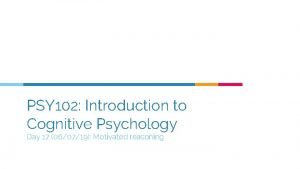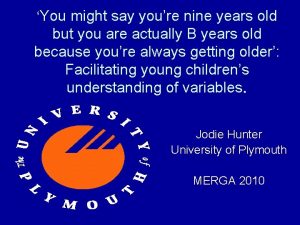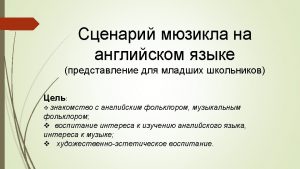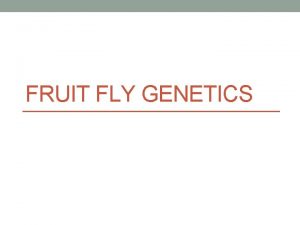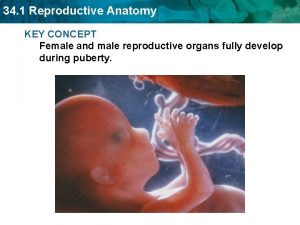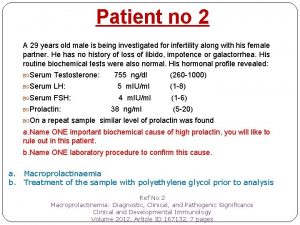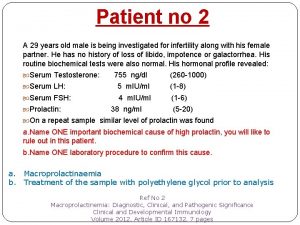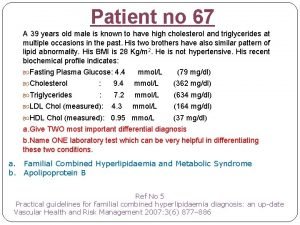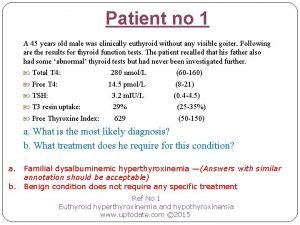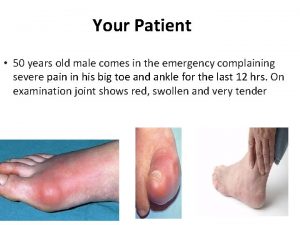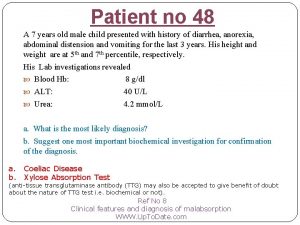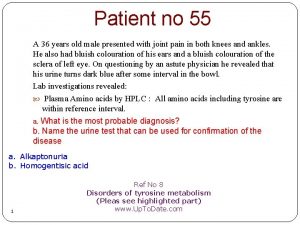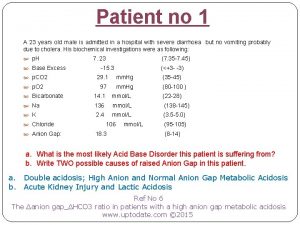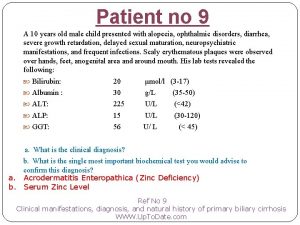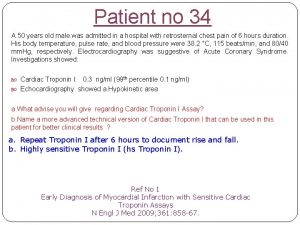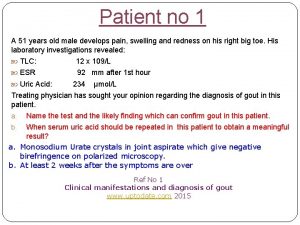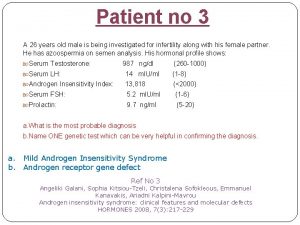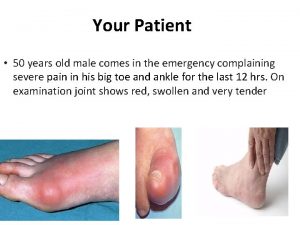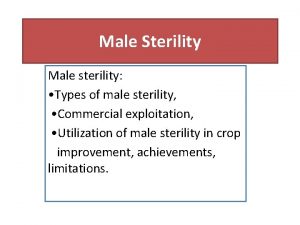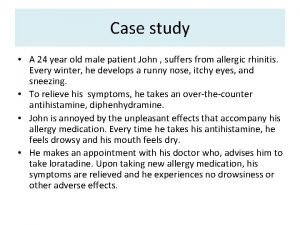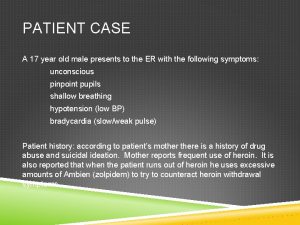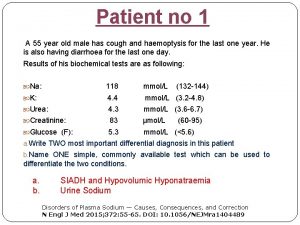Patient no 36 A 60 years old male























- Slides: 23

Patient no 36 A 60 years old male has type 2 diabetes mellitus, hypertension and stage 2 chronic kidney disease. He has reported to a A&E of a hospital with abdominal pain, vomiting and confusion state. His pulse is 58/min and BP is 85/40 mm. Hg. He is on a long list of medication but his wife suspects he has erroneously overdosed metformin. His lab profile was: p. H 7. 10 (7. 35 -7. 45) Base Excess (<+3 - -3) -9. 0 p. CO 2 25. 2 mm. Hg (35 -45) p. O 2 57 mm. Hg Bicarbonate 11. 8 mmol/L (80 -100 mm. Hg) (22 -28) Na 142 mmol/L (138 -145 mmo/L) K 6. 3 mmol/L (3. 5 -5 mmo/L) Chloride Urea 83. 0 mmol/l (95 -105 mmol/l) 34. 0 mmol/l Creatinine 760 μmol/l (2. 5 -7. 7 mmol/l) (50 -120 μmol/l) Prothombin time: Prolonged a. What is the most likely diagnosis? b. Name ONE most important lab investigation to confirm the diagnosis a. Lactic Acidosis (due to overdosed Metformin and Co-morbidities) b. Plasma Lactate levels Metformin Overdoasage www. uptodate. com © 2015 Up. To. Date

Lactic Acidosis Lactic acidosis is very common cause of metabolic acidosis Biguinide overdosage is notorious to cause lactic acidosis Phenformin has been withdrawn due to marked lactic acidosis Lactic acidosis due to metformin over-dosage occurs mainly in patients with co-morbid conditions. In an otherwise normal person it is rare. Please see attached article for biochemical mechanism of lactic acidosis due to metformin

Patient no 37 A 15 -year-old boy, diagnosed with Type 1 diabetes mellitus 6 years ago, presented with a 36 -hour history of malaise, abdominal pain, and a reduced conscious level. On examination he was drowsy and breathing rapidly and deeply. His biochemistry on admission was as follows: Sodium 120 mmol/L Potassium 5. 9 mmol/L Bicarbonate 8. 4 mmol/L Urea 14. 9 mmol/L Creatinine 444 µmol/L Glucose 52. 0 mmol/L Urine ketones +++ a. Which ketone species is likely to be present in the largest concentration in his serum? b. State TWO possible causes for this episode of diabetic ketoacidosis in this patient. a. β-hydroxbutyrate b. Missed taking insulin and Underlying infection Diabetic Ketoacidosis www. uptodate. com © 2015 Up. To. Date

Diabetic Ketoacidosis is characterized by the presence of acetoacetic acid (true ketone), betahydroxybutyrate (derivative of acetoacetate) and acetone (a true ketone but not an acid) In normal serum ratio of acetoacetic acid and betahydroxybutyrate is 1: 1 In DKA this ratio is disturbed in favour of betahydroxybutyrate and in severe DKA, the ratio of betahydroxybutyrate and acetoacetic acid may become 10: 1 Nitropruside test (Rothra`s test) routinely carried out in urine and serum does not react with betahydroxybutyrate

Patient no 38 A 33 years old female is pregnant for 15 weeks. Her BMI is 33 Kg/m 2. Her father was also diabetic. Her biochemical tests shows: Fasting Plasma Glucose: 7. 8 mmol/L Hb. A 1 c : 7. 5 % (59 mmol/mol ) a. What is the most likely diagnosis? b. Which etiological class of Diabetes Mellitus (DM) this patient belongs to? a. Overt DM (DM in Pregnancy) b. Type 2 DM Please see following slides for description

Hyperglycaemia in Pregnancy Hyperglycaemia can cause dreadful complications in pregnancy. It can present with more than one ugly faces: a. Pre-gestational DM: This term is sometimes used for women who are known cases of DM and become pregnant. Diagnosis of these cases is not required during pregnancy b. Overt DM: . Full blown DM diagnosed at any stage of pregnancy is called Overt DM. The incidence of this category is increasing with worsening life style and increased prevalence of type 2 DM in women. WHO has endorsed this category in 2013 but with the term ‘Diabetes is Pregnancy’ (without the word ‘Overt’). c. Gestational DM (GDM): Women with onset or first recognition of abnormal glucose tolerance during any stage of pregnancy (other than those in overt category). Ref No 2 a American Diabetes Association Standards of Medical Care In Diabetes— 2015

Diagnosis of Overt DM is diagnosed at any stage of pregnancy if ONE of the following is present: Glycosylated Haemoglobin (A 1 c)*: ≥ 6. 5% Fasting Plasma Glucose: ≥ 7. 0 mmol/L (126 mg/dl) Random blood glucose**: > 11. 1 mmol/l (200 mg/dl) 2 -h plasma glucose (following a 75 g oral glucose load) : >11. 1 mmol/l * Should be carried out only in first trimester by an NGSP Ref No 2 b certified method. Diagnostic Criteria and Classification of Hyperglycaemia First Detected in ** Should NOTPregnancy WHO/NMH/MND/13. 2 (2013) be advised except in situations where suspicion of DM is strong

Diagnosis of GDM is diagnosed at any stage of pregnancy if any one of the following is present following a 75 g oral glucose load: Fasting : Between 5. 1 -6. 9 mmol/l (92 -125 mg/dl) 1 hour: >10. 0 mmol/l (180 mg/dl) 2 -hour: Between 8. 5 – 11. 0 mmol/l (153 -199 mg/dl) Ref No 2 b Diagnostic Criteria and Classification of Hyperglycaemia First Detected in Pregnancy WHO/NMH/MND/13. 2 (2013)

Summary of Screening Protocols Pregnancy<24 wks Fasting Plasma Glucose (FPG) Random Plasma Glucose (RPG) Hb. A 1 c FPG<5. 1 mmol/L or FPG>5. 1 mmol/L but <7 mmol/L Hb. A 1 c <6. 5 or RPG<11. 1 mmol/L 75 g 2 hr GTT at 24 -28 wks FPG>7 mmol/L or Hb. A 1 c >6. 5 or RPG>11. 1 mmol/L GDM No further testing Pregnancy>24 wks 75 g 2 hour GTT Overt DM No further testing

Lets do some exercise with some more cases

Supplementary Patient 1 A 28 years old female is pregnant for 19 weeks. Her BMI is 21 Kg/m 2. Her screening tests showed: Fasting Plasma Glucose: 6. 2 mmol/L Hb. A 1 c : 5. 7% a. What is the most likely diagnosis? b. Which etiological class of Diabetes Mellitus this patient belongs to? a. GDM b. GDM

Supplementary Patient 2 A 29 years old female is pregnant for 25 weeks. Her BMI is 22 Kg/m 2. OGTT was carried out for screening which showed: Fasting : 6. 4 mmol/l 1 hour: 8. 5 mmol/l 2 -hour: 7. 7 mmol/l a. What is the most likely diagnosis? b. Which etiological class of Diabetes Mellitus this patient belongs to? a. GDM b. GDM

Patient no 39 A 21 years old male has been diagnosed to have Diabetes Mellitus (DM). His father, paternal uncle and grandfather were also diabetic. His BMI is 21 Kg/m 2. He responded very well to sulfonylureas and did not require insulin for control. At the time of diagnosis his important lab investigations showed following results: Fasting Plasma Glucose: 9. 2 mmol/L (166 mg/dl) Urine Glucose : +++ Anti-Islet cell antibodies: Negative Anti GAD antibodies: Negative. Name the type of DM, he is suffering from? b. Name the laboratory investigations required for confirmation of his a. Maturity Onset Diabetes of the Young (MODY) diagnosis. a. b. Genetic Testing Ref No 4 Classification of diabetes mellitus and genetic diabetic syndromes www. uptodate. com © 2015

MODY is different from type 2 DM because this is a group of monogenetic disorders. It is classified in ‘other specific types’ of WHO classification About 6 types of MODY have been described with different genetic defects and clinical features (Please see next slide) High paternal inheritance and glycosuria are characteristics of type 3 (hepatocyte nuclear factor 1 alpha defect)


Patient no 40 A 61 years old male is a known patient of Diabetes Mellitus (DM) and is presently on insulin therapy for the control of his DM. He has reported in A&E Department of a hospital with symptoms of hypoglycaemia. His capillary blood glucose measured in hospital is 3. 6 mmol/L (65 mg/dl). a. b. Which class of hypoglycaemia this patient is suffering from? What advise you will give to this patient regarding management of these symptoms in future? a. Documented Symptomatic Hypoglycaemia b. The treatment plan has to be revised to avoid such incidence Ref No 3 Seaquist ER, Anderson J, Childs B, et al. Hypoglycemia and diabetes: a report of a workgro up of the. American Diabetes Association and the Endocrine Society. J Clin Endocrinol Metab 2013; 98: 1845.

Hypoglycaemia in Diabetics No need to demonstrate Whipple`s triad in diabetics. Ignoring such symptoms in diabetics can be dangerous. Hypoglycaemia in diabetics, may be documented or undocumented, should be taken as an urgent issue Some modification of treatment should be advised to avoid untoward incidence while patient is driving etc.


Patient no 41 (Recent Updates) A 47 years old male has been diagnosed to be having type 2 diabetes mellitus. He is being investigated for the assessment of glucose control. A new marker 1, 5 -Anhydroglucitol (1, 5 -AG) was also analysed. The result shows: Fasting Plasma Glucose : 11. 2 mmol/L Hb. A 1 c: 7. 6 % 1, 5 -AG: 6 μg/ml a. What does the result of 1, 5 -Anhydroglucitol (1, 5 -AG) indicates in this patient? b. Write ONE biochemical basis of change in 1, 5 -AG in in this patients. a. Uncontrolled DM b. Glucose competes with 1, 5 AG for reabsorption in kidney. When glucose is high, 1, 5 AG cannot be reabsorbed and is decreased in serum Ref No 10 Elizabeth Selvin, Andreea M. Rawlings, Morgan Grams, Josef Coresh, Ronald Klein, Michael Steffes. Association of 1, 5 -Anhydroglucitol with Diabetes and Microvascular Conditions. Clinical Chemistry 60: 11: 1409– 1418 (2014)

Patient no 42 (Recent Updates) A 31 years old pregnant female has BMI of 32 Kg/m 2. Following are the results of her biochemical investigations carried out at 26 th week of pregnancy: OGTT with 75 g glucose Fasting Plasma Glucose : 6. 2 mmol/L One hour: 11. 2 mmol/L Two hours: 9. 3 mmol/L HOMA-IR: 6. 4 (<2. 2) She is subject of a study carried out to evaluate the role of Adeponectin and Insulin Like Growth Factors 1 (IGF 1) in GDM. The researchers are also studying the association of High Molecular Weight (HMW) adeponectin with insulin resistance a. What is your expectation of Adeponectin and IGF 1 levels in this patient (increased or decreased) b. What is the expected HMW Adeponectin to total adeponectin ratio in this patient (increased or decreased) a. Decreased b. Decreased Ref No 10 Adiponectin and IGFBP-1 in the development of gestational diabetes in obese mothers. BMJ Open Diabetes Research and Care 2014; 2: e 000010. doi: 10. 1136/ bmjdrc-2013 -000010

Patient no 43 A 10 years old boy, who is a known patient of Type 1 Diabetes Mellitus, is admitted in an Intensive Care Unit in semi-conscious state. His biochemical picture shows: Plasma Glucose 15. 6 mmol/L p. H : 7. 21 (7. 35 -7. 45) Na : 140 mmol/L (135 -150) K : 6. 2 mmol/L (3. 5 -5. 0) Cl : (98 -106) 100 mmol/L HCO 3 : 13. 8 mmol/L (22 -28) Anion Gap: 26 Serum Ketone (By Nitroprusside test): Negative a. Why nitroprusside test is negative in this patient in spite of evidence of Diabetic Ketoacidosis (DKA)? b. Name the biochemical tets which can be more useful in this patient to diagnose DKA. a. Nitroprusside reacts with acetoacetate and acetone and not with beta hydroxybutyrate. b. Estimation of beta hydroxybutyrate in the blood Ref No 7 Diabetic ketoacidosis and hyperosmolar hyperglycemic state in adult s: Clinical features, evaluation, and diagnosis www. uptodate. com © 2015

Patient no 44 A 15 years old male has been referred to you for the investigation of polyuria which he has developed for the last a few weeks. He is a known patient of Type 1 DM for the last 7 years. He has loss of vision due to a cranial nerve lesion diagnosed in an Ophthalmology Clinic. He also complains of hearing loss. An examination by ENT specialist reveals that he is gradually developing neural deafness. His plasma glucose and protein: Creatinine Ratio are within desirable ranges. Water deprivation test was done with following results: Six hours after Fluid Restriction: Serum Osmolality : 294 m. Osmol/L Urine Osmolality: 128 m. Osmol/L Post Vasopressin Serum Osmolality : 282 m. Osmol/L Urine Osmolality: 786 m. Osmol/L What is the most probable diagnosis? (Please name one disease in which all these features fit in) Wolfram syndrome comprising type 1 diabetes mellitus and optic atrophy, known as DIDMOAD (Diabetes Insipidus, Diabetes Mellitus, Optic Atrophy, and Deafness). Ref No 9 Wolfram Syndrome presenting with optic atrophy and diabetes mellitus: two case reports http: //www. casesjournal. com/content/2/1/9355

DIDMOAD Rare disease (Rare disease are diagnosed by consultants!!) Constellation of features mentioned in the two case reports in the accompanying literature (Ref No 9).
 Four scores and seven years ago
Four scores and seven years ago Sheep years to human years
Sheep years to human years 300 solar years to lunar years
300 solar years to lunar years Patient 2 patient
Patient 2 patient Chapter 24 trauma overview
Chapter 24 trauma overview How did judas die
How did judas die Despite being thousands of years old
Despite being thousands of years old Lydia is 48 years old single outspoken and very bright
Lydia is 48 years old single outspoken and very bright Hello song by peter weatherall
Hello song by peter weatherall Republic act number 9344
Republic act number 9344 Under 15 years old
Under 15 years old New years old is new again
New years old is new again Are you nine years old
Are you nine years old Sredni vashtar story
Sredni vashtar story Hello
Hello Xxxbritt
Xxxbritt Geert vinck
Geert vinck How old old are you
How old old are you Once upon a time there lived a little country girl
Once upon a time there lived a little country girl Once upon a time there lived an old man and an old woman
Once upon a time there lived an old man and an old woman Once upon a time hansel
Once upon a time hansel Male gaze laura mulvey
Male gaze laura mulvey Difference between male and female drosophila
Difference between male and female drosophila Colon function in male reproductive system
Colon function in male reproductive system







